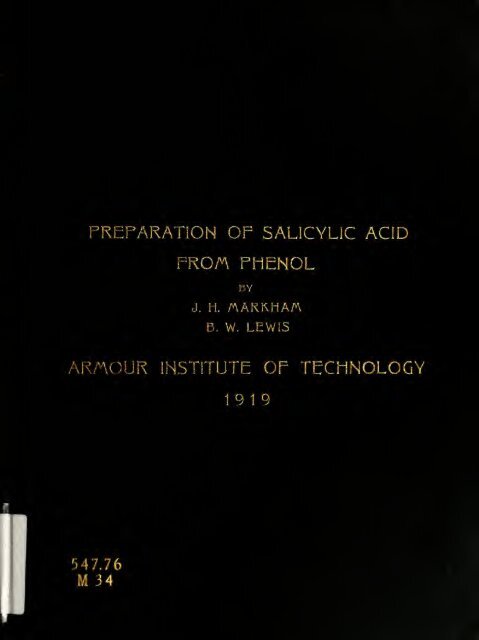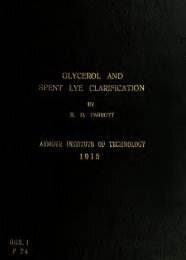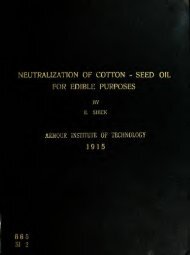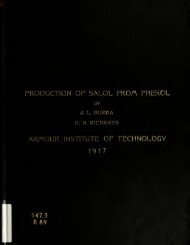The preparation of salicylic acid from phenol
The preparation of salicylic acid from phenol
The preparation of salicylic acid from phenol
Create successful ePaper yourself
Turn your PDF publications into a flip-book with our unique Google optimized e-Paper software.
UNWERSJi^ V LiBEARIES
1<br />
Iat 514<br />
'Markham, J. H.<br />
i<strong>The</strong> <strong>preparation</strong> <strong>of</strong><br />
<strong>acid</strong> <strong>from</strong> <strong>phenol</strong><br />
<strong>salicylic</strong>
Digitized by tine Internet Arcliive<br />
in 2009 witli funding <strong>from</strong><br />
CARLI: Consortium <strong>of</strong> Academic and Researcli Libraries in Illinois<br />
http://www.archive.org/details/<strong>preparation</strong><strong>of</strong>salOOmark
<strong>The</strong> Preparation <strong>of</strong> Salicylic Acid<br />
FROM Phenol<br />
a thesis<br />
PRESENTED BY<br />
J. H. MARKHAM AND B. W. LEWIS<br />
TO THE<br />
PRESIDENT AND FACULTY<br />
OF<br />
ARMOUR INSTITUTE OF TECHNOLOGY<br />
FOR THE DEGREE OF<br />
BACHELOR OF SCIENCE<br />
IN<br />
CHEMICAL ENGINEERING<br />
MAY 29, 1919<br />
APPROVED<br />
I'lnA-^scr ^(.r <strong>of</strong> i.f CCtKiiiicnl<br />
KiiK'iitrcrinsr<br />
^H\C^GO. ^^ " Dran <strong>of</strong> Cultunil Sl.iilies
PROBLEM<br />
I H D S X<br />
PAGE<br />
OCGUEHENCE MD LETHODS OF PREPAHATIOil 3<br />
KOLBE'S PROCESS<br />
PHYSICAL PROPERTIES<br />
CHEMICAL PROPERTIES<br />
USES 0? SALICYLIC ACID 20<br />
OUR I.IETHOD OP PREPARATIOII 25<br />
EXPSRIMEITTAL RUIIS<br />
PURIEICATIOE<br />
THE CHEMISTRY OE TEE SCHMIDT METHOD 36<br />
COECLUSIOH<br />
REEEREKCES<br />
2S1S5<br />
2<br />
7<br />
10<br />
14<br />
30<br />
3^<br />
^°<br />
^^
This work v;as done under the general direction<br />
and supervision <strong>of</strong> Pr<strong>of</strong>essor Harry McCormack,<br />
for which respectful acknowledgment is hereby<br />
made.<br />
1.
PROBIEI.I.<br />
Preparation <strong>of</strong> Salicylic <strong>acid</strong> <strong>from</strong><br />
<strong>phenol</strong>. Using <strong>phenol</strong> as a starting substance<br />
to prepare the <strong>acid</strong>, to study the process and<br />
to purify the product. It was originally in-<br />
tended to start v.ith tenzol and go thru the<br />
synthesis <strong>of</strong> sodium phenate, tut since the<br />
price <strong>of</strong> <strong>phenol</strong> has reached such a lov; price,<br />
and since the synthesis <strong>of</strong> <strong>phenol</strong> is now more<br />
or less standard, the process starts with <strong>phenol</strong><br />
and caustic soda.
OCCUnRElJCE AllD LIETHODE OF PP.EPAHATIOIT<br />
Ortho-hyuroxy-carboxylic <strong>acid</strong>, or<br />
ortho-hydroxy-'bensoic <strong>acid</strong> or ortho-hydroxy-<br />
c art oxy-b eri z ene<br />
C H<br />
7 6 3<br />
C H . OH.COOH (1-2)<br />
6 4<br />
COOH<br />
H OE<br />
H H<br />
E<br />
<strong>The</strong> <strong>acid</strong> v.as first discovered by<br />
H. Piria in 16S9, by fusing <strong>salicylic</strong> alde-<br />
hyde v;ith potassium hydroxide. Calhours<br />
proved in 1843 that oil <strong>of</strong> v.intergreen is<br />
mainly methyl salicylate. In 1653 A. Ho fnan<br />
converted anthranilic <strong>acid</strong> into <strong>salicylic</strong><br />
<strong>acid</strong> by means <strong>of</strong> nitrous <strong>acid</strong>. Finally Ilolbe<br />
and lautemann prepared it synthetically <strong>from</strong><br />
<strong>phenol</strong>, sodium and carbon dioxide in 1673.
Natural <strong>salicylic</strong> <strong>acid</strong> is<br />
found in many plants, usually in the form <strong>of</strong><br />
methyl salicylate or oil <strong>of</strong> v.inter^reen<br />
C^H fOH)COOOII-<br />
6 4 3<br />
<strong>The</strong> <strong>acid</strong> may be obtained <strong>from</strong> the<br />
following plants: Gaulterla fragrantissima,<br />
Gaulteria procumbeus, Gaulteria punctata,<br />
Gaulterla leukocarpa, Betula lenta, Llonotropa<br />
hypopitis, Spiraea ulmaria, Gloria superba and<br />
<strong>from</strong> many other plants. <strong>The</strong> <strong>acid</strong> is also found<br />
in very small quantities in some grapes, strav,-<br />
berries, cherries and in fact in most fruits.<br />
Salicylic <strong>acid</strong> may be prepared by one<br />
<strong>of</strong> the following methods:<br />
1. 3y oxidation <strong>of</strong>, or by fusion vfith<br />
potassium hydroxide, or by electrolysis <strong>of</strong> one<br />
<strong>of</strong> the following substances; salicin, salicyc<br />
aldehyde, and saligenin.<br />
2. 2y fusing potassium hydroxide with<br />
one <strong>of</strong> the following substances; benzoic <strong>acid</strong>.
indigo, coumarin, ortho-chlor-benzoic <strong>acid</strong>, ortho-<br />
toluene Bulphonio <strong>acid</strong> , ortho-cresol-sulphonic<br />
<strong>acid</strong>, ethyl-cresol-sulphonic <strong>acid</strong>.<br />
3. By heating with water ortho-diazo-<br />
amldobenzoic <strong>acid</strong>.<br />
4. By dry distillation <strong>of</strong> calciutn salt <strong>of</strong><br />
anie <strong>acid</strong> or meta-oxybenzoic <strong>acid</strong>.<br />
5. 3y reaction <strong>of</strong> potassium permanganate<br />
on the potassium salt <strong>of</strong> o-cresolsulphonic <strong>acid</strong>.<br />
.6. By heating <strong>phenol</strong> with carbon tet-<br />
rachloride and alco::olic potash; p-oxybenzoic<br />
<strong>acid</strong> is here also obtained.<br />
C H OH+CCl + 6 KOE -* C H .OZ.GOOX * ZOL *<br />
6 5 4 6 4<br />
SHgO<br />
7. By oxidation <strong>of</strong> toluene ortho-phos-<br />
phonic <strong>acid</strong> with alkaline potassium permanganate.<br />
8. By distillation <strong>of</strong> sodium phenyl car-<br />
bonate in a current <strong>of</strong> carton dioxide with sodium<br />
phenate.<br />
<strong>acid</strong>.<br />
9. By action <strong>of</strong> nitrous <strong>acid</strong> on anthranilic
10. By electrolysis <strong>of</strong> a solution <strong>of</strong> ben-<br />
zoic <strong>acid</strong> ii) acetic <strong>acid</strong>.<br />
11. By exposing a solution <strong>of</strong> benzoic <strong>acid</strong><br />
to the sunlight in the presence <strong>of</strong> a ferric salt.<br />
1£, By passing dry carbon dioxide into a<br />
hot mixture <strong>of</strong> <strong>phenol</strong> and sodium.<br />
(Kolbe and lautemann)
KOIBE'S PROCESS.<br />
This method has teen used for the manu-<br />
facture <strong>of</strong> <strong>salicylic</strong> <strong>acid</strong> on a large scale.<br />
Equivalent quantities <strong>of</strong> pure <strong>phenol</strong><br />
and a concentrated solution <strong>of</strong> sodium hydroxide<br />
are thoroughly mixed and evaporated to dryness in<br />
iron vessels with constant stirring. When the<br />
mass is dry it is pulverized, placed in a metal<br />
retort and heated to 100°C while a current <strong>of</strong><br />
heated dry carton dioxide is passed in. <strong>The</strong> mass<br />
is kept well stirred and the temperature is slow-<br />
ly raised to 180°G. This operation takes several<br />
hours. After the retort has ceen heated for some<br />
time the <strong>phenol</strong> begins to distill over. V/hen the<br />
evolution <strong>of</strong> <strong>phenol</strong> ceases, the temperature is<br />
raised to 200°C and the operation stopped. When<br />
the mass has cooled, it is dissolved in v.ater and<br />
the resinous substances precipitated with a miner-<br />
al <strong>acid</strong>, a further addition <strong>of</strong> <strong>acid</strong> precipitates<br />
<strong>salicylic</strong> <strong>acid</strong>, which is then purified.<br />
This process may be regarded as taking
place In four stages:<br />
1. Phenol and sodium hydroxide form<br />
sodium phenate:-<br />
C-HpOH ^ ITaOH ^ C-H^ONa * H^O<br />
6 5 6 5 E<br />
E. Carton dioxide when added to the<br />
sodium phenate forms sodium phenyl cartonate:-<br />
C^H^OHa * CO^ = C^H^.OCO^.lTa<br />
6 5 E 6 5 E<br />
This stage is completed v.hen the mass is heat-<br />
ed to about 110°G for one hour.<br />
3. <strong>The</strong> sodium phenylcartonate is trans-<br />
formed into sodium salicylate:-<br />
C^H^.OCO^.lIa = C^H,.0H.C001Ia<br />
6 5 £ 6 4<br />
<strong>The</strong> COg goes into the Ortho-position tetv.-een<br />
the hydrogen atom and the neucleus, producing a<br />
caroxyl group.<br />
4. In the last stage the salt acts with<br />
some unchanged sodium phenate and sets free the<br />
TDhenol in the disodium salt
C H .OH.COOIIa-C H^.OlIa = C H .Ol^Ta.COOlIa * G H^OH<br />
64 65 64 65<br />
This change takes place during the last stage <strong>of</strong><br />
heating.
physicjVI properties .<br />
Salicylic <strong>acid</strong> crystallizes irotn ^vater<br />
in long white needles, having a sweetish astrin-<br />
gent taste. From alcohol <strong>salicylic</strong> <strong>acid</strong> crystal-<br />
lizes in large colorless monoclinic prisms.<br />
<strong>The</strong> <strong>acid</strong>, has a specific gravity <strong>of</strong><br />
1.48£ - 1.465 at 4^0; melting point 158° - 159°3.<br />
Pure <strong>salicylic</strong> <strong>acid</strong> dried in vacuum over sulphuric<br />
<strong>acid</strong> gives a melting point <strong>of</strong> 158, 5°C. Small<br />
amounts <strong>of</strong> p-hydroxybenzoic <strong>acid</strong> lower the melt-<br />
ing point. ".Vhen slov/ly heated to 200°G is sub-<br />
limes, and on cooling deposits in long fine<br />
needles; when rapidly heated to 200°C it vala-<br />
tilizes and the vapors undergo a partial dis-<br />
sociation into <strong>phenol</strong> and carton dioxide, accord-<br />
ing to the formula:<br />
? a^ k : 254.9<br />
l-a2<br />
7/here P^pressure in cm. <strong>of</strong> mercury,<br />
a=rdegree <strong>of</strong> dissociation. This is an irreversible<br />
reaction.<br />
10,
Heat <strong>of</strong> comTDustion <strong>of</strong> <strong>salicylic</strong> <strong>acid</strong><br />
is 5162 cal. per gram or 754990 cal. per mole-<br />
cule. Heat <strong>of</strong> formation <strong>from</strong> <strong>phenol</strong> 5520 cal.;<br />
latent heat <strong>of</strong> futic/. - 6550 cal.; heat <strong>of</strong> neu-<br />
tralisation <strong>of</strong> a solution <strong>of</strong> the <strong>acid</strong> with l/E<br />
molecule <strong>of</strong> sodium hydroxide 12910, and v.-ith<br />
another half molecule .810 cal.<br />
Salicylic <strong>acid</strong> is slightly soluble in<br />
cold vvater or petroleuoi ether, hut (luite soluble<br />
in hot water.<br />
0°<br />
11.
<strong>The</strong> <strong>acid</strong> is very soluble in chlor<strong>of</strong>orm,<br />
alcohol, ether, aceton and ethyl acetate.<br />
12.<br />
100 parts <strong>of</strong> ether dissolve at 15° 50.47 <strong>of</strong> <strong>acid</strong><br />
100<br />
100<br />
100<br />
100<br />
100<br />
100<br />
absolute alcohol dissolve 49.65 <strong>of</strong> <strong>acid</strong><br />
90;'o 42.09
Vv'ater solutions.<br />
steam.<br />
Chlor<strong>of</strong>orm or ether remove it <strong>from</strong><br />
Salicylic <strong>acid</strong> can "be distilled in<br />
<strong>The</strong> para-<strong>acid</strong> and traces <strong>of</strong> the meta-<br />
<strong>acid</strong> usually accompany the ortno-<strong>acid</strong> if extreme<br />
care is not ohserved in <strong>preparation</strong>.<br />
15.
CHEMICAL PROPiiRTIES.<br />
Salicylic <strong>acid</strong> is both an <strong>acid</strong> and a<br />
<strong>phenol</strong>. It forms three sets <strong>of</strong> salts; <strong>acid</strong>,<br />
"basic and neutral, as well as ethers.<br />
'.Vhen heated to 200° G it decomposes<br />
into <strong>phenol</strong> and carbon dioxide<br />
CgK^.OH.COOH<br />
= GgHg.OH * CO^<br />
Heated in a closed vessel with water<br />
it decomposes into <strong>phenol</strong> and carbon dioxide at<br />
2E0°-230°; a similar decomposition takes place<br />
when treated with con. hydrochloric or hydrobromic<br />
<strong>acid</strong>, or with dil. sulphuric at 140°-1500 , or with<br />
con. phosphoric at 120°.<br />
Phosphorus trichloride gives qjI^ClPOg,<br />
which is decomposed by water into <strong>salicylic</strong> <strong>acid</strong><br />
14.<br />
and phosphoric <strong>acid</strong>. When treated with phosphorous<br />
pentachloride and the products distilled, ortho-<br />
chlorbenzoylchloride is obtained. Phosphorous<br />
pentabromide yields raonobrom-<strong>salicylic</strong> <strong>acid</strong>, and<br />
this on heating with alcohol or <strong>phenol</strong> gives the
esters <strong>of</strong> salicj^lic <strong>acid</strong>. Phosphorous oxychloride<br />
gives on heating <strong>salicylic</strong> anhydride.<br />
Salicylic <strong>acid</strong> or its salts give a deep<br />
violet coloration in a neutral solution v/ith fer-<br />
ric salts. This reaction is used for qualitative<br />
as well as quantitative determinations <strong>of</strong> sali-<br />
cylic <strong>acid</strong>. 2his test is sensitive to about<br />
1:550,000. Hov/ever <strong>phenol</strong> or <strong>salicylic</strong> aldehyde<br />
give the same test. <strong>The</strong> color is not removed<br />
hy acetic <strong>acid</strong>. This test fails, if for one part<br />
<strong>of</strong> <strong>salicylic</strong> <strong>acid</strong> there is present 365 parts <strong>of</strong><br />
sodium nitrate or 36 parts <strong>of</strong> sodium chloride.<br />
Dry hot ammonia breaks up <strong>salicylic</strong><br />
<strong>acid</strong> into <strong>phenol</strong> and carbon dioxide.<br />
On oxidation with potassium bichromate<br />
in sulphuric <strong>acid</strong> carbon dioxide and v.ater are<br />
produced.<br />
Potassium chlorate and hydrochloric<br />
<strong>acid</strong> oxidize it to chloranil.<br />
Potassium permanganate oxidizes it to<br />
formic <strong>acid</strong> and carbon dioxide.<br />
15,
On oxidation witli potassium persul-<br />
phate in an alkaline solution and subsequent<br />
colling with an <strong>acid</strong> hydroquinone carboxylic<br />
<strong>acid</strong> is obtained.<br />
tion products.<br />
Chlorine forms mono- and di- substitu-<br />
Dil. nitric <strong>acid</strong> forms nitro-<strong>salicylic</strong><br />
<strong>acid</strong>, while con, nitric <strong>acid</strong> forms picric <strong>acid</strong>.<br />
Sodium amalgam in the presence <strong>of</strong><br />
boric <strong>acid</strong> produces <strong>salicylic</strong> aldehyde.<br />
oxybenzophenone.<br />
On heating v/ith resorcin it gives tri-<br />
Sodium and amyl alcohol reduce it<br />
chiefly to pimelic <strong>acid</strong>.<br />
Concentrated sulphuric <strong>acid</strong> gives mono-<br />
sulpho-<strong>salicylic</strong> <strong>acid</strong>.<br />
By heating v.ith concentrated sulphuric<br />
<strong>acid</strong> and potassium ferrocaynide phthallc <strong>acid</strong> is<br />
obtained. xhe same product is obtained when<br />
<strong>salicylic</strong> <strong>acid</strong> is heated vvith oxalic <strong>acid</strong> and<br />
glycerin.<br />
16,
Y/hen <strong>salicylic</strong> <strong>acid</strong> is heated with<br />
"butyl alcohol and zinc chloride a homologue<br />
01 the <strong>acid</strong> is obtained, which on distillation<br />
goes into tutyl <strong>phenol</strong>.<br />
azo-compounds.<br />
It cotahines v^ith diazo-hodies to form<br />
nitrous <strong>acid</strong> passed into an etherial<br />
solution <strong>of</strong> <strong>salicylic</strong> <strong>acid</strong> gives nitro- and<br />
diaao-oxyhenzoic <strong>acid</strong>s.<br />
C.H^(OH).GOIIPhH.<br />
o 4<br />
At 210° aiiiline gives <strong>phenol</strong> and<br />
Gyanamide and alcohol at 100° form<br />
urea and ortho-oxybenzoic ether.<br />
Phenol and stannic chloride at 120°<br />
give op-di-oxy'benzophenone,<br />
V.'ith camphor it forms a compound<br />
C H 0„2G, H 0, which melts at 50°.<br />
7 6 3 10^5 •<br />
On heating with soda lime <strong>phenol</strong> and<br />
carton dioxide are formed<br />
C^H, (OH) GO. OH Geo = C,H_OH - GaCO_<br />
6 4 o 5 o<br />
17,
Potassium persulphate added to a<br />
solution <strong>of</strong> <strong>salicylic</strong> <strong>acid</strong> and potassium hy-<br />
droxide forms a crystalline compound<br />
C H (CO K)OSO K<br />
A solution <strong>of</strong> <strong>salicylic</strong> <strong>acid</strong> and borax<br />
in water deposit crystals <strong>of</strong> a composition<br />
4 10 7<br />
Chloral forms with it at 140^^<br />
^ 4 cue 5<br />
In dilute aqueous solutions "bromine<br />
water gives « a x>recipitate <strong>of</strong> C;.Hr;Br.O,<br />
-^ -^ Oct<br />
16.<br />
Iodine and potash give a red pov.der GgH^KODCOgZ.<br />
It forms compounds with casein,<br />
fihrim and albuminoid, containing about 14;j <strong>of</strong><br />
the <strong>acid</strong> and having a foraiula — *^7E^11 ^^'18^^82<br />
2C H . It melts at 40°, and is soluble in<br />
7 6 S<br />
water to an extent <strong>of</strong> ,0051 parts in 100 parts<br />
<strong>of</strong> water.
".'.Tien taken Internally it is excreted<br />
as salicyluric <strong>acid</strong> or salicyl-glycocoll —<br />
19.
USES 0? SAIICYLIC ACID.<br />
Salicylic <strong>acid</strong> is largely used in the<br />
<strong>preparation</strong> <strong>of</strong> pharmaceuticals. <strong>The</strong> <strong>acid</strong> is<br />
also <strong>of</strong> importance in the manufacture <strong>of</strong> syn-<br />
thetic chemicals, such as dye stuffs. Its chief<br />
pharmaceutical uses are as an antirheumatic and<br />
as an antiseptic. Llany states and countries<br />
forhid its use as a food .preservative in which<br />
field it formally found one <strong>of</strong> its largest uses.<br />
<strong>The</strong> <strong>acid</strong> finds extensive use in the<br />
production <strong>of</strong> salicylates. V/hen ethyl alcohol<br />
and sulfuric or hydrochloric <strong>acid</strong> reacts with<br />
the <strong>salicylic</strong> <strong>acid</strong>, ethyl salicylate results.<br />
Llethyl salicylate, oil <strong>of</strong> wintergreen may be pre-<br />
pared <strong>from</strong> methyl alcohol and the <strong>acid</strong>s in the<br />
same manner. Llethyl salicylate is extensively<br />
prescribed for external uses. Allyl salicylate<br />
which is prepared in the manner as described<br />
above, is used both medicinally and as a perfume.<br />
Phenyl salicylate, Salol , another derivative <strong>of</strong><br />
the <strong>acid</strong> is a very important pharmaceutical; but<br />
because <strong>of</strong> its cost, other salicylates are sub-<br />
EO,
stituted. V/hen phosphorous oxychloride is<br />
allowed to react with the <strong>acid</strong> phenyl sali-<br />
cylate is thus formed. Acetyl <strong>salicylic</strong> <strong>acid</strong>,<br />
"Aspirin", is prepared <strong>from</strong> <strong>salicylic</strong> <strong>acid</strong> and<br />
acetyl chloride. "Aspirin finds extensive use<br />
in the treatment <strong>of</strong> rheumatic conditions. All<br />
<strong>of</strong> the Salicylic <strong>preparation</strong>s taken internally,<br />
are used for T;he henefit <strong>of</strong> the <strong>salicylic</strong> <strong>acid</strong><br />
v/hich is liberated in the decomposition <strong>of</strong> the<br />
compound. Quinine salicylate is one <strong>of</strong> the<br />
few compounds, prepared directly <strong>from</strong> the sodium<br />
salt.<br />
Among the most important <strong>salicylic</strong><br />
salts vi'hich are used in the <strong>preparation</strong> <strong>of</strong> anti-<br />
rheumatic compounds are: tolypyrinesalicylate<br />
<strong>salicylic</strong>-sulfonic <strong>acid</strong>, salicylamide, salicyl-a-<br />
methyl -phenyl -hydrazone and methl-acetyl-salicylate.<br />
It is interesting to note that in the production<br />
<strong>of</strong> the raethyl-acetyl-salicylate, anhydous zinc<br />
chloride is said to act as a catalytic agent.<br />
21.
<strong>The</strong> next important use <strong>of</strong> salicyio <strong>acid</strong><br />
is in the synthesis <strong>of</strong> many important organic<br />
bodies.<br />
<strong>The</strong> first <strong>of</strong> these "bodies to receive<br />
consideration is Saligenin.<br />
CH OH<br />
£<br />
OH<br />
(y-3)<br />
This "body is prepared <strong>from</strong> <strong>salicylic</strong><br />
<strong>acid</strong>, thru the amide, and the reduction <strong>of</strong> the<br />
latter with sodium amalgam in <strong>acid</strong> solutiOii.<br />
Trichlor-a-a-glyceric <strong>acid</strong> is pre-<br />
pared by the action <strong>of</strong> potassium chlorate and<br />
hydrochloric <strong>acid</strong> upon <strong>salicylic</strong> <strong>acid</strong>. V/hen<br />
<strong>salicylic</strong> <strong>acid</strong> is iodised by various methods,<br />
among our products are iouo<strong>salicylic</strong> <strong>acid</strong>, vhich<br />
on rapid heat-inr gives iodo<strong>phenol</strong>, <strong>from</strong> which<br />
catechol can be obtained.<br />
^^uinol, hydroq^uii'Oiie, paradihydroxy-<br />
benzene, 1-4 phendiol may be synthesized <strong>from</strong><br />
<strong>salicylic</strong> <strong>acid</strong>.<br />
B2.
First the <strong>salicylic</strong> <strong>acid</strong> is iodised<br />
or 'brominated so a.s to form 5 iodo- or 5 crom-<br />
<strong>salicylic</strong> <strong>acid</strong> which on fusion v/ith potash<br />
gives 2:5 dihydroxy "ceni'-oic <strong>acid</strong>. This "body on<br />
dry distillation yields quinol. This same tody<br />
may he prepared ty first nitrating the <strong>salicylic</strong><br />
<strong>acid</strong> into the 5-nitro <strong>acid</strong> and then to the 5-<br />
amino <strong>salicylic</strong> <strong>acid</strong>, thence converting to the E-5<br />
dihydroxy"benzoic <strong>acid</strong> hy the diazo method.<br />
llote: <strong>The</strong> 5-amino-<strong>salicylic</strong> <strong>acid</strong> is best pre-<br />
pared by the redaction <strong>of</strong> benzeneazoealicylic<br />
<strong>acid</strong>. 5-lTitro<strong>salicylic</strong> <strong>acid</strong> on heating with lime<br />
gives p- nitro<strong>phenol</strong>, -..hich can be reduced to p-<br />
amido<strong>phenol</strong> .<br />
and<br />
treated as above.<br />
Salicylic <strong>acid</strong> yields gentisic <strong>acid</strong> by<br />
direct oxidation with potassium persulphate in<br />
alkaline solution.<br />
hyde<br />
Anisic alde?iyde: p-methoxyben::oic alde-<br />
CHO<br />
OCH<br />
25.
This liOdy is found in the volatile oil<br />
<strong>from</strong> the wood and the bark <strong>of</strong> the Chione glabra.<br />
It cari ce prepared <strong>from</strong> <strong>salicylic</strong> <strong>acid</strong> by first<br />
converting to the aldehyde then thru S-methoxy-<br />
benzoylacetic ester.<br />
Euxanthone<br />
xhis body exists in euarthic <strong>acid</strong> or<br />
Indian Yellov.-. It is found in the free state<br />
In coloring matter resulting <strong>from</strong> decomposition.<br />
Upon nitration, <strong>salicylic</strong> <strong>acid</strong> yields 5-nitro<br />
and upon reduction forms 5-araino<strong>salicylic</strong> <strong>acid</strong>.<br />
<strong>The</strong> amino- <strong>acid</strong> gives gentisic <strong>acid</strong> by the diaso<br />
method.<br />
<strong>The</strong>re are numerous other bodies that<br />
are prepared synthetically by means <strong>of</strong> the sali-<br />
cylic <strong>acid</strong> and its salts.<br />
E4.
OUR Iffi'xHOD OP PREPAHATIOH. (4th Ruii)<br />
<strong>The</strong> materials used were pure sodium<br />
hydroxide and crystalline <strong>phenol</strong>. 120 grans<br />
<strong>of</strong> sodium hydroxide are dissolved in an equal<br />
weight <strong>of</strong> v.ater in a porcelain dish and cooled.<br />
This is slowly added to 260 grams <strong>of</strong> <strong>phenol</strong> in<br />
a shallow enameled pan, about 14xGxl". <strong>The</strong><br />
mixture is well stirred up and kept cool. This<br />
gives a mixture v/hich is only slightly colored.<br />
It is now placed in the vacuum drying chest to<br />
ce evaporated to dryness. A vacuum <strong>of</strong> atout 2£"<br />
is maintained and the temperature is kept down<br />
to 50°-6C 2. <strong>The</strong> temperature must be just high<br />
enough so that the mass will barely boil. <strong>The</strong><br />
temperature must ce kept low in ordei- to avoid<br />
charring. This is a very essential step in the<br />
process.<br />
<strong>The</strong> mass will gradually begin to<br />
thicken and in about three hours it will be<br />
completely solid. It is now removed <strong>from</strong> the<br />
drying chest and quickly powdered in an iron<br />
25,
mortar to a fine powder. <strong>The</strong> fine material is<br />
nov/ placed back in the drying chest, tut the<br />
steam is turned <strong>of</strong>f, and it is dried for about<br />
half an hour.<br />
<strong>The</strong> pov/der thus obtained is sodium<br />
phenate. It is pinkish Y/hite in color, somev/hat<br />
hygroscopic and very soluble in vvater, acetone<br />
or alcohol.<br />
'.Vhen dry the sodium phenate is placed<br />
in the autoclave and the lid is put on. <strong>The</strong><br />
autoclave used was made <strong>of</strong> copper, about 14"<br />
tall and about 6" in diameter and about S/16"<br />
thick. <strong>The</strong> lid was furnished with a lead gasket<br />
and it formed a tight joint with the body <strong>of</strong> the<br />
autoclave. <strong>The</strong> cover had a safety valve, a<br />
passage for gas and a well for a thermometer.<br />
<strong>The</strong> lid was fastened by means <strong>of</strong> a heavy bracliet.<br />
26,
Having placed the sodium phenate into<br />
the autoclave and the lid put in place, it is<br />
now tightly clamped in its seat. <strong>The</strong> gas inlet<br />
in autoclave cover is connected by means <strong>of</strong> heavy<br />
rubber tubing to an iron pipe containing calcium<br />
chloride. This pipe is about £' long and 1" in<br />
diameter; it is filled v;ith granular calcium c'nlor-<br />
ide protected at both ends with glass v.ool and<br />
wire gauze. <strong>The</strong> other end <strong>of</strong> this pipe is con-<br />
nected to a carbon dioxide tank cy means <strong>of</strong> extra<br />
heavy rubber tubing.<br />
<strong>The</strong> autoclave is now suspended in such<br />
a manner, that the bottom is immersed to a depth<br />
<strong>of</strong> atout 3" in running cold water. <strong>The</strong> carbon<br />
dioxide gas is turned on, the pressure in the auto-<br />
clave is not allowed to exceed 10 lbs. This is<br />
kept up for about an hour when the pressure is in-<br />
creased to 75 lbs. and at the same time the cool-<br />
ing is discontinued. V.lien no more carbon dioxide<br />
is being absorbed, the pressure is brought up to<br />
75 lbs. again and allowed to stand for about one<br />
hour.<br />
27.
<strong>The</strong> cooling during the first stages<br />
<strong>of</strong> the carhon dioxide ahsorhtion is quite a<br />
desirable feature, because the temperature tends<br />
to rise considerably and if the mass is not<br />
cooled, <strong>phenol</strong> is split <strong>of</strong>f, the mass chares and<br />
fuses together making further absorbtion diffi-<br />
cult.<br />
A paraffin bath is nov; brought under<br />
the autoclave so that the bottom vdll be immersed<br />
in paraffin to a depth <strong>of</strong> about 5". <strong>The</strong> temper-<br />
ature 01 the bath is gradually raised to 120° G<br />
and for four hours the temperature is carefully<br />
kept at 120°-140°C. <strong>The</strong> temperature <strong>of</strong> paraffin<br />
bath must ue taken and not the temperature in<br />
the well in the autoclave cover. <strong>The</strong> latter<br />
temperature is about 50° below the temperature<br />
<strong>of</strong> the paraffin bath.<br />
At the end <strong>of</strong> the four hours the auto-<br />
clave is allowed to cool <strong>of</strong>f. V.'hen cool the auto-<br />
clave is opened, the mass is transferred to a dish<br />
and water added. <strong>The</strong> water is brought to a boil<br />
and a few o.c. <strong>of</strong> con. hydrochloric <strong>acid</strong> added.<br />
£8.
This throws out the tarry matter and creosotic<br />
<strong>acid</strong>s. This is separated in a separatory funnel.<br />
<strong>The</strong> solution is now cooled and more hydrochloric<br />
<strong>acid</strong> added. This throws out the impure sali-<br />
cylic <strong>acid</strong>.<br />
<strong>The</strong> impure <strong>acid</strong> is collected by fil-<br />
tration and is dried. Yield 44 gr. or 16;^ <strong>of</strong><br />
the theoretical.<br />
With some modifications this is the<br />
Sohmitt method <strong>of</strong> <strong>preparation</strong> <strong>of</strong> <strong>salicylic</strong> <strong>acid</strong>.<br />
29.
EZPERILffiKTAI RUKS. (1st Run)<br />
lEO gr. <strong>of</strong> sodium hydroxide were ais-<br />
solved in an equal amount <strong>of</strong> water and mixed into<br />
260 gm. <strong>of</strong> <strong>phenol</strong>. This was evaporated at 140°C<br />
and 14" vacuum. 350 grams <strong>of</strong> sodium phenate ob-<br />
tained. This was dark hrovai in color and very<br />
hygroscopic. <strong>The</strong> phenate was powdered up, placed<br />
in under a pressure <strong>of</strong> 10 Ihs., which was increas-<br />
ed to 50 Ihs. in the course <strong>of</strong> half an hour. <strong>The</strong><br />
autoclave "became very warm during the passage <strong>of</strong><br />
carbon dioxide. This pressure was kept up for<br />
two hours, then it was removed and the contents<br />
<strong>of</strong> the autoclave examined. <strong>The</strong> mass was dark<br />
"brown in color and <strong>of</strong> a thick pasty consistency;<br />
it smelt strongly <strong>of</strong> <strong>phenol</strong>. <strong>The</strong> cover ".vat re-<br />
placed and 50 lbs, <strong>of</strong> pressure applied <strong>from</strong> the<br />
oar'Lon dioxide tank. <strong>The</strong> autoclave was placed<br />
in a paraffin bath and heated for two hours at<br />
130°-145°C. During this heating the pressure<br />
inside the autoclave went up to 60 lbs.<br />
At the end <strong>of</strong> the two hours the auto-<br />
30.
clave was allov;ed to cool <strong>of</strong>f, and the contents<br />
were examined. <strong>The</strong> mass v.as <strong>of</strong> a dark brov.n<br />
color, moist and covered on top with fine cry-<br />
stals <strong>of</strong> <strong>phenol</strong>. This was transferred to an<br />
evaporating dish and dissolved in hot water. A<br />
little hydrochloric <strong>acid</strong> threw dov.Ti the tarry<br />
matter which was separated out. <strong>The</strong> remaining<br />
part was tested with ferric chloride after the<br />
excess <strong>of</strong> hydrochloric <strong>acid</strong> was neutralized with<br />
calcium cartonate. <strong>The</strong> test did not show the<br />
presence <strong>of</strong> salicylate.<br />
31,
EZPERIIJIEKTAI RUNS. (End Run)<br />
<strong>The</strong> same amounts <strong>of</strong> <strong>phenol</strong> and sodium<br />
hydroxide used as in the previous run. Evapor-<br />
ated at 100°C and 18" vacuum.<br />
<strong>The</strong> sodium phenate obtained was light<br />
brovm in color and hygroscopic. It was poudered ,<br />
placed in the autoclave and carton dioxide gas<br />
passed in at a pressure <strong>of</strong> 10 lbs. and within<br />
half an hour this was gradually increaeed to 60<br />
lbs. <strong>The</strong> autoclave became very warm. <strong>The</strong> press-<br />
ure was kept up for two hours, then removed and<br />
the contents examined. <strong>The</strong> mass was brown in<br />
color, moist and s;nelt <strong>of</strong> <strong>phenol</strong>. <strong>The</strong> cover was<br />
now replaced and 60 lbs. <strong>of</strong> pressure applied <strong>from</strong><br />
the carbon dioxide tank. <strong>The</strong> autoclave was heat-<br />
ed for three hours at 150°-145°C. <strong>The</strong> pressure<br />
in the autoclave increased during heating to 70<br />
lbs.<br />
At the end <strong>of</strong> the three hours the auto-<br />
32.<br />
clave was allowed to cool <strong>of</strong>f and the mass examined,<br />
It was brown in color, somewhat moist and covered
with crystals <strong>of</strong> <strong>phenol</strong>.<br />
This was treated as in the first run,<br />
and the ferric chloride gave a very strong test.<br />
However, there v.as not enough salicylate present<br />
to allow <strong>of</strong> its isolation in a oure state.
ESPSRIMEIITAL RUUS. (Srd Run)<br />
<strong>The</strong> same amounts <strong>of</strong> <strong>phenol</strong> tmd sodium<br />
hydroxide used. <strong>The</strong> mixture was evaporated at<br />
60°C and 22" vacuum. <strong>The</strong> sodium phenate obtain-<br />
ed v.as pinkish v.hite in color and slightly hy-<br />
groscopic.<br />
It v.as powdered and placed in the auto-<br />
clave. Carbon dioxide gas was passed in at a<br />
pressure <strong>of</strong> 5 Ihs. and the autoclave v,as cooled<br />
by means <strong>of</strong> running cold water, as descriced in<br />
Run 4. In the course <strong>of</strong> an hour the pressure<br />
was gradually increased to 70 lbs. and kept up<br />
for another hour. <strong>The</strong> pressure was now removed<br />
and the mass in the autoclave examined. It v.'as<br />
light in color, dry, porous and it had a faint<br />
odor <strong>of</strong> <strong>phenol</strong>.<br />
After the cover was replaced, 70 lbs.<br />
<strong>of</strong> pressure was applied <strong>from</strong> the caruon dioxide<br />
tank ana the autoclave heated at 120-1400G for<br />
four hours.<br />
After the autoclave had cooled <strong>of</strong>f the<br />
34.
mass was transferred to an evaporating dish. It<br />
was brownish gray in color, dry and had a faint<br />
odor <strong>of</strong> <strong>phenol</strong>. Hot v.-ater was added and after<br />
the tarry matter was separated out the impure<br />
<strong>salicylic</strong> <strong>acid</strong> was thrown out by another addit-<br />
ion <strong>of</strong> hydrochloric <strong>acid</strong>. [This was collected<br />
on the filter and dried. Yield 14 gr. or 4^.<br />
35.
PURIi'ICATIOlI Oi' THE lUPUHE ACID.<br />
<strong>The</strong> impure <strong>acid</strong> is dissolved in "boil-<br />
ing v.-ater and then neutralii:ed v/ith calcium<br />
oartonate and allowed to cool. Calcium sali-<br />
cylate separates oat in hard glistening crystals.<br />
A fairly pure <strong>acid</strong> yields almost pure white cry-<br />
stals, hut an impure <strong>acid</strong> gives brov.nish cry-<br />
stals. A second crystallization is ootained <strong>from</strong><br />
the mother liquor.<br />
<strong>The</strong> calcium salt is again crystallized<br />
<strong>from</strong> water, until a pure white salt is ohtaiii-<br />
ed. It is now decomposed with hydrochloric <strong>acid</strong><br />
and the pure sclicylic <strong>acid</strong> is washed with a<br />
little cold v.ater and finally crystallized out<br />
<strong>from</strong> dilute aloohol. This gives a very pure<br />
<strong>salicylic</strong> <strong>acid</strong> in the form <strong>of</strong> large prismatic<br />
crystals.<br />
After this purification only 29 gr.<br />
<strong>of</strong> pure <strong>acid</strong> was octained. or 6.3;: <strong>of</strong> the theo-<br />
retical yield.<br />
<strong>The</strong> chief impurities found in impure<br />
36,
<strong>acid</strong> are: <strong>phenol</strong>, creosotic <strong>acid</strong> due to impure<br />
<strong>phenol</strong>, para-hydroxy-benzoic <strong>acid</strong> and a-hydroxy-<br />
Iso-phthalic <strong>acid</strong> due to the presence <strong>of</strong> caustic<br />
BOda and to a too high or too low temperature<br />
in the manufacture.<br />
<strong>The</strong> presence <strong>of</strong> a small amount <strong>of</strong> Jm-<br />
puritiee causes the <strong>acid</strong> to crystallize <strong>from</strong><br />
dilute alcohol in the form <strong>of</strong> a mass <strong>of</strong> inter-<br />
laced crystals instead <strong>of</strong> well defined large<br />
prisms.<br />
It is quite clear that with proper<br />
conditions present, the yield depends on the<br />
pressure. However, the highest pressure ob-<br />
tainahle with the equipment on hand v.as 75 lbs.<br />
per sq. in. , therefore no further runs were<br />
attem'oted.<br />
37.
TEE CH3LII£'i?Ry OF THE SCffi.IITT LETHOD.<br />
<strong>The</strong> chemistry <strong>of</strong> <strong>preparation</strong> <strong>of</strong> sali-<br />
cylic <strong>acid</strong> by the method proposed by Schinitt<br />
was explained by S. Tijmstra jun. (Ber.1905,<br />
58, 1375-1365)<br />
Kolbe method<br />
Sodium phenate is prepared as in the<br />
C H OH * llaOH = C H OKa * H<br />
6 5 6 5 2<br />
When carbon dioxide is passed into<br />
the sodium phenate and heated to 120°-130°C<br />
under pressure the resulting product is ortho-<br />
BOdoxybenzoic <strong>acid</strong> (sodium phenoxide-ortho-<br />
carboxylic <strong>acid</strong>)<br />
OUa.CgH^.COgH --<br />
OKa<br />
JQuH<br />
It is not identical with sodium sali-<br />
cylate. It has a greater dissociation tension<br />
than sodium salicylate. It slov?ly absorbs<br />
ammonia at ordinary temperatures. It is not<br />
38.
transformed into sodium salicylate when evapor-<br />
ated to dryness \\ith water. It changes complete-<br />
ly to sodium salicylate when dissolved in ace-<br />
tone. <strong>The</strong> ortho-sodoxyhenzoic <strong>acid</strong>, which is<br />
thus formed, on heating undergoes an isomeric<br />
change into sodium salicylate:<br />
ly into the nucleus.<br />
OH<br />
COOlJa<br />
This shows that the C0„ enters direct-<br />
2<br />
Y/hen sodium salicylate is heated in a<br />
closed tube for 2-12 hours at 248'^, it changes<br />
more or less completely into ortho-sodoxyhenzoic<br />
<strong>acid</strong>.<br />
S9.
CQKGIUSIOU.<br />
<strong>The</strong> proper v^orking co adit ions for<br />
the process are outlined under "Our Method<br />
<strong>of</strong> Preparation."<br />
However, for larger yields pressure<br />
up to 125 lbs. per so. in, or even higher<br />
should ce used.<br />
To use an enameled autoclave with<br />
a stirring device would he <strong>of</strong> decided advan-<br />
tage, because it would yield a purer and more<br />
uniform product and it would materially cut<br />
down the time necessary for the completion <strong>of</strong><br />
the reaction.<br />
<strong>The</strong> yield as well as the quality <strong>of</strong><br />
the product depends mainly on three requisites;<br />
the sodium phenate must not ce charred, it<br />
must be dry and well powdered; the carbon diox-<br />
ide must bo dry; the temperature must be<br />
closely controlled.<br />
40.
RE?ESE^TCES<br />
Neues HandwOrterlDuoh der Cheraie - 1890.<br />
Dictionnaire de Ghiinie - 1906.<br />
41.<br />
Thorp, Dictionary <strong>of</strong> Applied Chemistry, 7.4, - 1913.<br />
Die SyuthetiBchen Darstellimgsmethoden der<br />
Zohlenst<strong>of</strong>f-Verbindungen, Dr. Zarl Elbs - 1689.<br />
r/atts, Dictionary <strong>of</strong> Chemistry, V.5, - 1692.<br />
J. Chern Soc. 114. 11, 137-8.<br />
Ber. S. [Dijmstra, jun. , 1905, 36, 1375-65.













